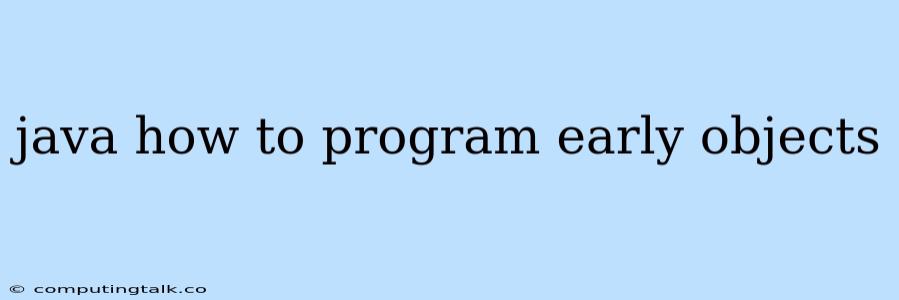Java is a powerful and widely used programming language that is known for its versatility and object-oriented nature. One of the key concepts in Java programming is the use of objects, which are fundamental building blocks of programs.
What are Objects in Java?
Objects are essentially instances of classes. A class acts as a blueprint or template that defines the properties (data) and behaviors (methods) of an object. For instance, you could create a Car class to represent a real-life car. This Car class might have properties like color, make, and model, and behaviors like startEngine and accelerate.
Why Use Objects?
Object-oriented programming (OOP) is a programming paradigm that emphasizes the use of objects. There are several benefits to using objects in Java:
- Modularity: Objects break down complex problems into smaller, manageable units. This makes code easier to understand, debug, and maintain.
- Reusability: Objects can be reused in different parts of a program or even in different programs, saving time and effort.
- Data Hiding: Objects protect their internal data (properties) from unauthorized access, promoting data integrity.
- Polymorphism: Objects can exhibit different behaviors depending on their type, making code more flexible and extensible.
Early Object Programming in Java: A Guide
Here's a step-by-step guide to programming with objects in Java:
-
Defining a Class:
public class Car { // Properties private String color; private String make; private String model; // Methods public void startEngine() { System.out.println("Engine started!"); } public void accelerate() { System.out.println("Car accelerating..."); } // Constructor public Car(String color, String make, String model) { this.color = color; this.make = make; this.model = model; } // Getters and Setters public String getColor() { return color; } public void setColor(String color) { this.color = color; } // ... similar getters and setters for other properties } -
Creating an Object (Instantiation):
public class Main { public static void main(String[] args) { Car myCar = new Car("Red", "Toyota", "Camry"); } } -
Accessing Properties and Methods:
public class Main { public static void main(String[] args) { Car myCar = new Car("Red", "Toyota", "Camry"); System.out.println("My car's color is: " + myCar.getColor()); myCar.startEngine(); } } -
Understanding Constructors: Constructors are special methods that are automatically called when a new object is created. They initialize the object's properties. In the example above, the
Carconstructor takes the color, make, and model as arguments and assigns them to the corresponding properties of the object. -
Using Getters and Setters: Getters and setters provide a controlled way to access and modify the properties of an object. Getters retrieve the values of properties, while setters modify them.
Simple Java Program Example:
public class Main {
public static void main(String[] args) {
// Create a Dog object
Dog myDog = new Dog("Buddy", "Golden Retriever", 5);
// Access properties and methods
System.out.println("My dog's name is: " + myDog.getName());
System.out.println("My dog's breed is: " + myDog.getBreed());
System.out.println("My dog's age is: " + myDog.getAge());
myDog.bark();
}
}
class Dog {
private String name;
private String breed;
private int age;
public Dog(String name, String breed, int age) {
this.name = name;
this.breed = breed;
this.age = age;
}
public String getName() {
return name;
}
public String getBreed() {
return breed;
}
public int getAge() {
return age;
}
public void bark() {
System.out.println("Woof!");
}
}
Key Takeaways:
- Java is an object-oriented language where objects are instances of classes.
- Objects encapsulate data (properties) and behavior (methods) to model real-world entities.
- Programming with objects promotes modularity, reusability, data hiding, and polymorphism.
- Classes define the structure and behavior of objects, while constructors initialize them.
- Getters and setters provide controlled access to an object's properties.
Conclusion
Early object programming in Java is a foundational skill that opens the door to more complex and powerful programming techniques. By understanding how to create and manipulate objects, you can write cleaner, more maintainable code that is both efficient and reusable.
